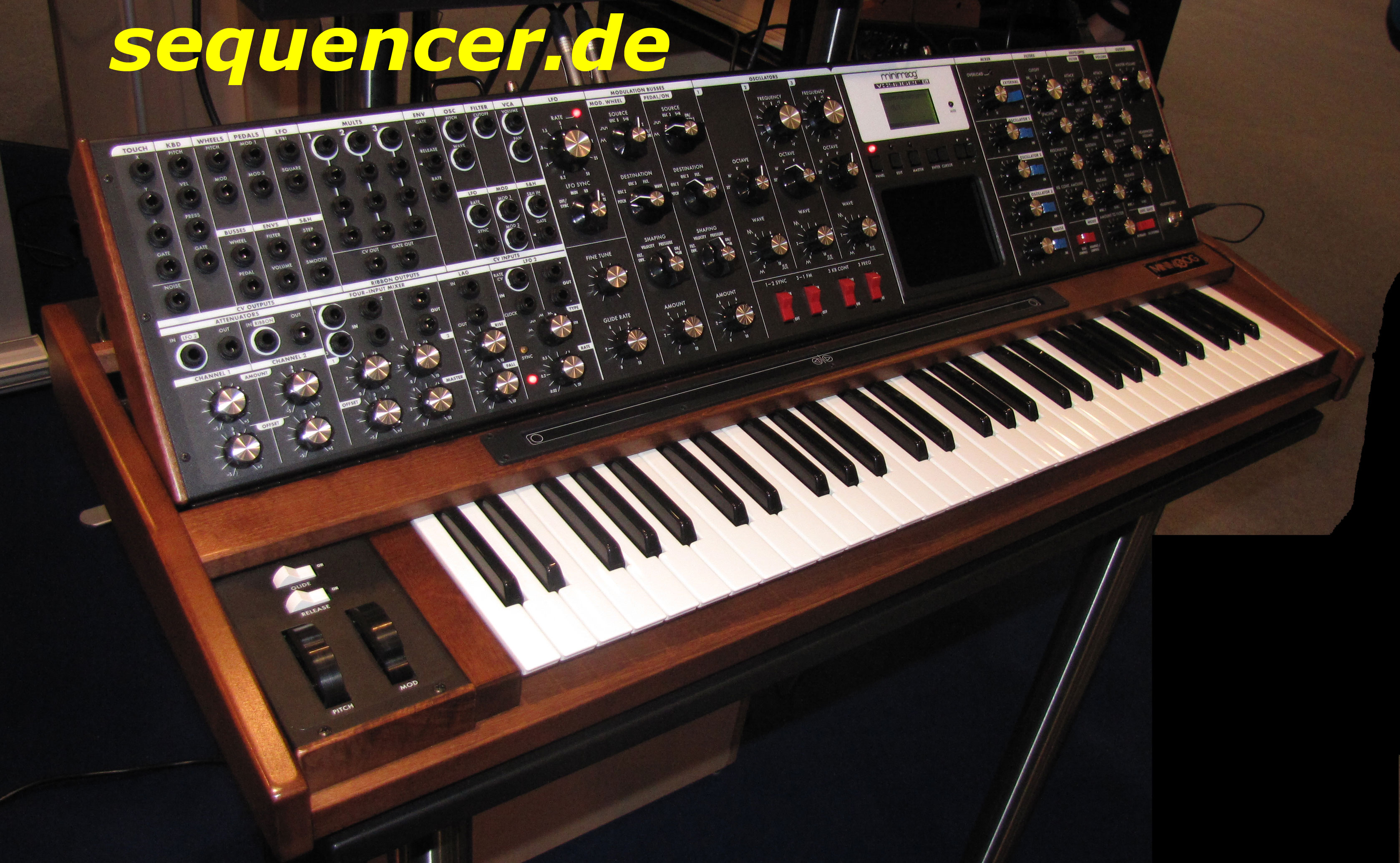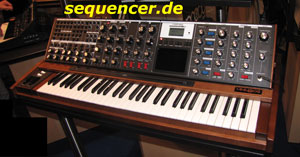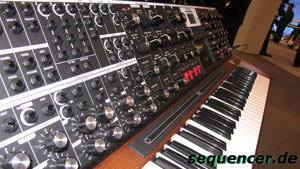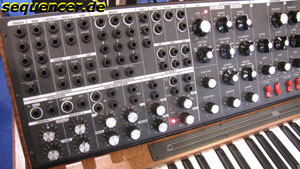MOOG
Minimoog Voyager XL Analog Synthesizer Moog
MinimoogVoyagerXL

Voyager Anniversary Version shown here.
click image to enlarge - Bild klicken zum vergroessern
other MOOG gear..
Built 2010
Type: analog
Hybrid: no
1 Voice / Stimmen
1x Multitimbral
standard Memory / Speicher
Value / Wert in 2017 ca. 4900 € (rare)
Synthesis: semi modular
OSC Features fm sync pwm
Wave Shapes morphing through waves pulse saw triangle + noise
3 OSCs
2 Filter lpf hpf self reso 4 Pole
2 LFOs triangle saw s+h smoothed s+h
2 Envelope Generators 2x ADSR
MIDI CONTROLLER CV GATE Control / Triggering
61 Keys with velocity aftertouch
Arpeggiator no
Sequencer no
(ID 775)
Type: analog
Hybrid: no
1 Voice / Stimmen
1x Multitimbral
standard Memory / Speicher
Value / Wert in 2017 ca. 4900 € (rare)
Synthesis: semi modular
OSC Features fm sync pwm
Wave Shapes morphing through waves pulse saw triangle + noise
3 OSCs
2 Filter lpf hpf self reso 4 Pole
2 LFOs triangle saw s+h smoothed s+h
2 Envelope Generators 2x ADSR
MIDI CONTROLLER CV GATE Control / Triggering
61 Keys with velocity aftertouch
Arpeggiator no
Sequencer no
(ID 775)


ABOUT The XL is basically the same as the Voyager but adds the two expandsion boxes VX251 and the "Moogerfooger" CP251, they add most of the V'gers internal outputs, multiples, a 4 ch-mixer, LAG processor and another LFO.
Also added is a larger Keyboard and a Ribbon Controller.
Yes, this reminds a bit of a larger MS20, it's still semimodular but fits nicely into a modular environment or may help to use the V'gers MIDI for external Synths as well.
this is the successor of the legendary minimoog, it has 2 filters with spacing, ADSR envelopes, an LFO, PWM and sync. well, if there is a classic synth, THIS is it! to be exact the minimoog is model D, the first 3 models did not see the market but were made of moogs modules (the filter, ENVs etc.) , the idea was to make a portable synthesizer with a keyboard, something quite new at that time. btw. the moog cascade (ladder) filter patent is no more valid. moog had to use the name big briar till he got his company name back. Bob Moog died in 2005.
Also added is a larger Keyboard and a Ribbon Controller.
Yes, this reminds a bit of a larger MS20, it's still semimodular but fits nicely into a modular environment or may help to use the V'gers MIDI for external Synths as well.
this is the successor of the legendary minimoog, it has 2 filters with spacing, ADSR envelopes, an LFO, PWM and sync. well, if there is a classic synth, THIS is it! to be exact the minimoog is model D, the first 3 models did not see the market but were made of moogs modules (the filter, ENVs etc.) , the idea was to make a portable synthesizer with a keyboard, something quite new at that time. btw. the moog cascade (ladder) filter patent is no more valid. moog had to use the name big briar till he got his company name back. Bob Moog died in 2005.
ABOUT Der XL ist weitgehend identisch mit dem normalen Voyager. Er ist hat eine größere Tastatur, dem VX351/352 (der 352 ist etwas umfangreicher da für Rackversion) und einem weiteren LFO, LAG Prozessor, 4-Kanal-Mixer und Multiples, also dem CP251.
Dazu kommt noch ein Ribbon Controller.
Das erinnert an den MS20 in "groß", ist aber immer noch semimodular, da man die Signalwege nicht selbst stecken kann. Er eignet sich sehr für ein analoges oder modulares Umfeld. Sein MIDI Interface könnte hier und da eine eigene MIDIfizierung ext. Hardware ersparen.
Der Nachfolger des klassischen Minimoog mit Sync, PWM, einen LFO und Doppelfilter mit Spacing und ADSR Hüllkurven und 2 Modulations-Bussen und natürlich Dynamik. noch klassischer geht es nicht, der Minimoog ist sicher der bekannteste Synthesizer auf der Welt? Der 2005 verstorbene Robert A. Moog (gesprochen Mohg, nicht Muug) baute ihn zunächst als Modell A aus Modulen des grossen Systems und das letzte Modell war der Minimoog D, der dann wirklich verkauft wurde. Er war als Liveinstrument gedacht und bis dahin wusste noch keiner wie ein Live-Synthesizer aussehen muss. Die beiden Modulationsräder sind heute Standard bei vielen anderen Synthesizern. Moog musste eine lange Zeit unter dem Namen Big Briar arbeiten. Das Patent auf den Moog-Kaskaden-Filter ist schon länger ausgelaufen.
ABOUT
Dazu kommt noch ein Ribbon Controller.
Das erinnert an den MS20 in "groß", ist aber immer noch semimodular, da man die Signalwege nicht selbst stecken kann. Er eignet sich sehr für ein analoges oder modulares Umfeld. Sein MIDI Interface könnte hier und da eine eigene MIDIfizierung ext. Hardware ersparen.
Der Nachfolger des klassischen Minimoog mit Sync, PWM, einen LFO und Doppelfilter mit Spacing und ADSR Hüllkurven und 2 Modulations-Bussen und natürlich Dynamik. noch klassischer geht es nicht, der Minimoog ist sicher der bekannteste Synthesizer auf der Welt? Der 2005 verstorbene Robert A. Moog (gesprochen Mohg, nicht Muug) baute ihn zunächst als Modell A aus Modulen des grossen Systems und das letzte Modell war der Minimoog D, der dann wirklich verkauft wurde. Er war als Liveinstrument gedacht und bis dahin wusste noch keiner wie ein Live-Synthesizer aussehen muss. Die beiden Modulationsräder sind heute Standard bei vielen anderen Synthesizern. Moog musste eine lange Zeit unter dem Namen Big Briar arbeiten. Das Patent auf den Moog-Kaskaden-Filter ist schon länger ausgelaufen.
DETAILS additional LFO reaches 50Hz max. 2 mod busses, The mini has 3 VCOs, the 3rd often works as LFO (LO setting) for modulation (moog modulars do not distinguish LFOs and VCOs), so it also works as FM source. btw: All OSCs have a LO setting. fast envelopes. all waveforms are seamless from pulse to tri to saw. HARDWARE: it has a pumped up Z80A aboard called Z180, remember ZX81? same, but more power with 1MB memory address capability, Z is for Zilog an AMD am29F010B ambit flash memory. a real biiig board with lots of chips (I mean huuuge, biig monster masses of chips..) the filters are CA3086-based.
DETAILS Der zusätzliche LFO reicht bis 50Hz. 2 Modulations-Busse, Der Mini hat 3 VCOs, einer davon kann als LFO dienen oder für FM genutzt werden. übrigens haben alle VCOs eine LO-Stellung .der bekannteste Trick ist sicher das Feedback des Ausgangssignals zurück in den Mixer um den Sound anzudicken. schnelle hüllkurven! Fußlagen 32 bis 2. wellenformen gehen ineinander über (PWM daher möglich und sweep tri nach saw).
DETAILS
SOUND fat basses and leads, percussion, performance instrument, has a nice multi touch 2D pad. hi quality sound. Perfect for modular oder analogue environment.
SOUND fette bässe und leads, perkussion, super für live, da gute Kontrolle und 2D-Pad, mit mehreren Berühungspunkten. hochwertiger klang. Im Umfeld analoger oder modularer Synthesizer sehr gut aufgehoben.
SOUND
VERSION Voyager and Voyager OS or Rack versions provide "less" but are smaller and can be expanded to meet the XLs functionality (exept the ribbon and Keyboard).
VERSION Die drei Voyager Modelle OS und Rack sowie die normale Version können über die VX und CP Erweiterung auf den gleichen Stand wie der XL gebracht werden, außer natürlich das Ribbon und Tastatur.
VERSION



